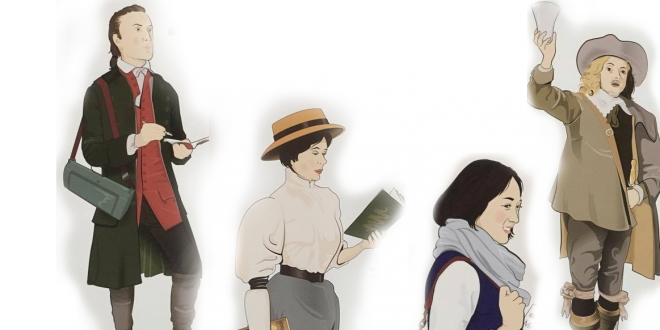What was the typical Lund student like in the 1700s or the 70s? And what are we like in 2017? The University has been trying to answer this question by making special roll up posters in time for the University’s 350th anniversary. The posters that are located around campus tell the story about the University history but also aim to make people laugh.
Written by Oskar Madunic Olsson Translated by: Rebecka McKinnon Forsell
Many students have been surprised by the roll ups featuring Lund students from different time periods. Every poster presents a typical student of Lund from a certain era and its background, field of study and aspirations for the future. The reader is also informed about how the students of the past lived, how old they were at the time of their higher education, how the studies were financed, how many students attended during their era and what language the studies were taught in.
The initiative of the posters, which is a part of the celebration of University’s 350th anniversary, was created by the same people who is behind the anniversary book Lunds Universitet under 350 år (Lund University – 350 years in the making), Fredrik Tersmeden, Björn Magnusson Staaf, Göran Larsson and Petra Francke. Petra Francke, who works with graphic design at the University Department of Communications, came up with the idea to create the posters.
“We wanted to acknowledge the 350th anniversary in a way that was visible around campus, even to those who don’t attend the anniversary events. I was imagining an exhibition of some sort and eventually it grew into this idea with the students of Lund through the ages,” says Petra Francke.
A Homogenous Group of Students
Presentations of the “typical” students would naturally entail some clichés and generalizations. Petra Francke says that it was easier to show a representative stereotype of a student from eras were the students were few and many of them had similar backgrounds.
“In the beginning, almost everyone studied theology. Later, in the 18th century, there were clear interests among the students like botany after Carl Linneaus and travels and studies that were considered “useful” to society. The 1968 student who was inspired by the left-wing protests and the student demonstrations were quite easy to produce,” says Petra Francke.

The facts about the students, their interests, their thoughts and their aspirations after their studies are to reflect the spirit of the different eras, but they are also written with a bit of tongue in cheek.
“We had fun when we wrote about the students, which you can probably tell,” says Petra Francke.
“Not Completely Unrealistic”
The students on the posters are all fictive. The 17th century student is accommodated (with 14 other students) with the professor of ethics, Johan Lundersten, who allegedly existed in real life.
“This wasn’t unheard of. The professors had difficulties getting paid and to earn some extra money they had students living with them,” says Petra Francke.
Another student is from 2017 and represents our own time. The student comes from the US and has chosen to study a Master’s degree in marketing in Lund after a Bachelor’s degree at the UCLA. She lives in the international student housing in Delphi, likes to watch Netflix and spends a lot of time thinking about the 2016 US Presidential Election. In the future, she aspires to work for Google.
“The modern student was the hardest one to make. The students today are so many and so different. But we have many international students and we have an exchange agreement with the University of California. To have someone from there to study here isn’t completely unrealistic,” says Petra Francke.







1 Comment
Fredrik Tersmeden
I notice that the name in English of the book mentioned in the article seems to be a free translation. The book however actually exists in an English language edition with the title “Lund University over 350 Years – History and Stories”. It can be found here at
http://www.lunduniversity.lu.se/article/jubilee-book-highlights-the-history-of-lund-university-in-popular-form